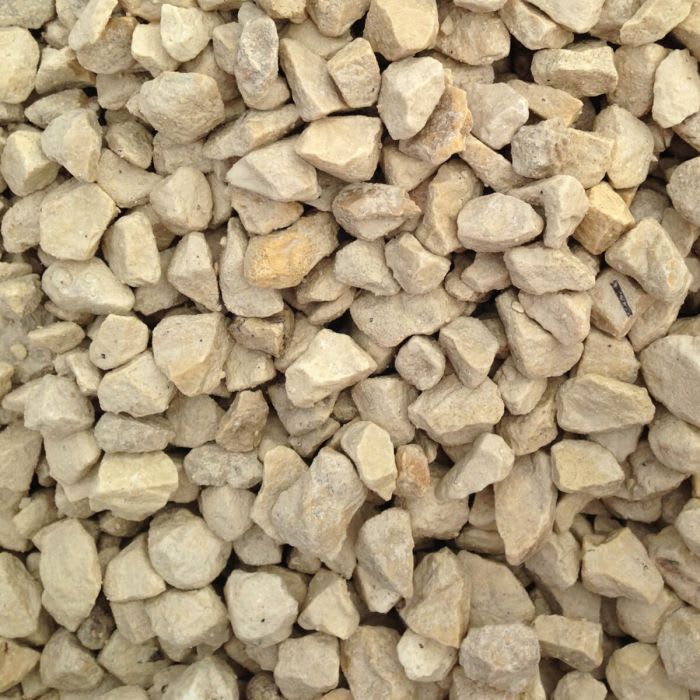Buff Cotswold Chippings
(2 Products)Buff Cotswold chippings ease transitions between hard and soft landscaping. Their tone is warm enough to soften metal or render but light enough to contrast with timber and stone. Whether used as ground cover or border detail, they allow other textures and colours to take the lead. The result is calm, connected, and considered.
About Buff Cotswold Chippings
Buff Cotswold chippings are a type of crushed limestone, broken down into sharp, angular fragments. The stone is naturally light in tone, typically ranging from pale yellow to soft cream, and tends to soften in colour as it weathers, settling into a warm, mellow finish over time.
Because each piece is crushed rather than rounded, the chippings interlock more easily than smooth gravel, forming a firmer surface underfoot.
Once laid, they sit closely enough to feel stable but still allow water to pass through freely, making them a suitable option for drainage-conscious areas like driveways, footpaths, or around planting.
The angular shape also means they’re less likely to shift or roll under movement, especially when laid at the correct depth. Whether used as ground cover, edging, or part of a full-surface finish, they give a neat, compact result with a natural, understated look.
Applications
They’re suitable for a wide range of domestic and light commercial applications:
- Driveways
- Pathways and walkways
- Garden borders and flowerbeds
- Front garden surfaces
- Low-maintenance planting areas
- Ground cover around paving or buildings
Because their colour is neutral, Buff Cotswold chippings blend well with timber, stone, brick, and most types of planting. They’re popular in both rural and urban settings - anything from cottages to new-builds.
Benefits
- They reflect light well, which helps open up darker corners of a garden or shaded driveways.
- The chippings don’t hold water - they let it pass through easily, making them ideal where drainage is needed.
- When laid over a membrane, they form a low-maintenance surface that resists weed growth and stays tidy year-round.
- You can use them as a standalone surface or in combination with paving, stepping stones, or edging.
Things To Keep In Mind
- Limestone Is Softer Than Other Aggregates: Under heavy vehicle use, the pieces can break down or compact over time.
- Light Colour Shows Dirt and Leaves: You may need to rake or sweep more often, especially in autumn or near trees.
- Sharpness Underfoot: The chippings are angular, not rounded. That helps them stay in place, but they’re not ideal for bare feet or very soft footwear.
Sizing
Buff Cotswold chippings usually come in two sizes:
- 10mm - Better for footpaths and lighter use areas. Slightly smoother underfoot.
- 20mm - More suited to driveways, borders, or areas that need a bolder texture.
Always factor in a bit extra for dips, edges, and settlement.
Laying Tips
- Start with a clean, weed-free surface
- Fit a good quality landscape membrane
- Add edging (timber, brick, metal) to keep the chippings contained
- Spread evenly with a rake
- After a few weeks, inspect and top up any low spots if needed
How They Age Over Time
When first laid, the stone may look a bit dusty or dry. That’s normal. After a few rains, the dust washes off and the colour settles into a clean, natural finish. Over time, the cream tone softens and blends into its surroundings. It's not a harsh or glaring white - more of a mellow, aged stone look.
Frequently Asked Buff Cotswold Chippings Questions
Can They Be Used On Driveways?
Yes, for light to moderate use. If the driveway gets heavy daily traffic or HGVs, a harder gravel (like granite or flint) may be more suitable long term.
What’s The Best Size To Use?
For paths and lighter use, 10mm is common. For driveways or decorative borders, most people choose 20mm. Both sizes work well with weed membranes and edging.
Are They Suitable Around Plants?
Absolutely. They're often used in planting beds, around shrubs, and beneath trees. They allow water through and help reduce weed growth.
Do I Need A Membrane?
Yes. While you can lay chippings straight onto soil, you'll get a much better result with a weed membrane underneath. It keeps things cleaner and reduces weed growth significantly.
What Colour Are They Exactly?
They’re a natural buff, somewhere between light yellow and cream. It’s a soft, warm colour - not bright white or harsh beige. It tends to mellow over time.
Will They Discolour Or Go Green?
If they’re under trees or shaded areas, they may pick up some algae or moss over time. That’s true of most light-coloured stone. A quick wash or rake-over usually keeps them looking fresh.
Can They Be Used With Other Materials?
Yes, they work well with stepping stones, sleepers, slabs, or as a border filler around patios. The colour sits well alongside timber, brick, concrete, or natural stone.





